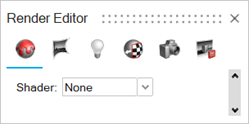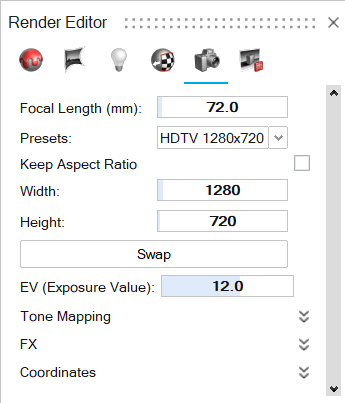Edit the Camera
By customizing the camera's position, angle, rendering image resolution, and rendering image quality, you can view and render your models from multiple perspectives and create a more distinctive scene.
Define the Camera's Rendering Resolution
Choose from a list of presets or enter a custom width and height.
-
On the Rendering tab, select the
Editors tool.
The Render Editor appears.

-
Select the Camera tab.

-
In the Render Editor, you can do the following:
- Select from a list of Presets.
- Enter a custom Width and
Height. Tip:
- To maintain the aspect ratio, select Keep Aspect Ratio.
- To swap the width and height, click the Swap button.
Define the Camera's Rendering Quality
Configure various options such as panoramic, depth of field, exposure, tone mapping, filtering, and rendering effects.
-
On the Rendering tab, select the
Editors tool.
The Render Editor appears.

-
Select the Camera tab.

-
In the Render Editor, you can define the following options:
Option Description Exposure Value (EV) Controls the camera's shutter speed. Lower values result in brighter images. For an overly bright scene, use a positive value. For an overly dark scene, use a negative value. Tone Mapping - White Balance (K)
- Can be used to balance an image using color temperature. A value of 6500K is usually used to balance light coming from the sun.
- Filmic
- The Filmic option only works if you turned on
Filmic in the Camera/Rendering settings.
- Highlights
- Higher values will make highlights stronger.
-
- Shadows
- Higher values will make shadows darker.
- Burn
- The burn value minimizes the burnt areas of an image. Lower values will reduce burnt areas.
- You can use Burn to compress a high dynamic range into a low dynamic range image, displayable on screens and other limited range devices.
- Setting Burn to 100% has the same effect as disabling it.
- Gamma
- Default value: 2.2. Lower values will make the image darker while higher values will give a washed-out look.
- Gamma correction is important if you want to display an image accurately on a computer monitor. It controls the overall brightness, as well as the ratios of red to green to blue, of an image. Without proper gamma correction, the image can look bleached out or too dark.
- Sharpness
- The default value (50%) is a balance between blurring and sharpening. Only applicable when Supersampling is set to Normal or High.
- A value near 0% will produce a more blurred image, while a value near 100% produces a more sharpened image.
- Chroma
- Chroma enhances the color of the image, acting like a saturation control.
- Higher values result in more saturated images. Setting Chrome to 0% has the same effect as disabling it.
- Brightness
- Use a value from ‐100% to 100% to control the tone of the texture. A brightness of ‐100% makes the image completely black.
- Contrast
- Higher values will give higher contrast.
FX - Glare
- Introduces a bloom effect in the final image.
- Choose from Radial, 5 Blades, 6 Blades, 8 Blades, or 12 Blades.
- Weight: Controls the intensity of the glare effect.
- Radius: Define the length of the blades.
- Vignetting
- It mimics the phenomenon where light comes through the lenses near the edges. Higher values will make the edges of the image look darker.
Coordinates - Position
- Enter precise x, y, z coordinates or drag the Position point in the modeling view to change the camera's position.
- Target
- Enter precise x, y, z coordinates or drag the Target point in the modeling view to change the camera's target.
- Orientation
- Enter precise x, y, z coordinates to change the camera's orientation.
Note: In the modeling window, drag the rectangle of Field of View to resize the observable area seen through the camera.